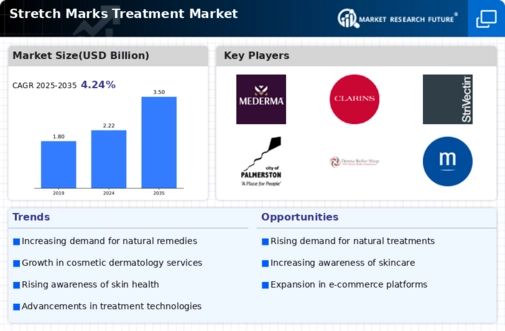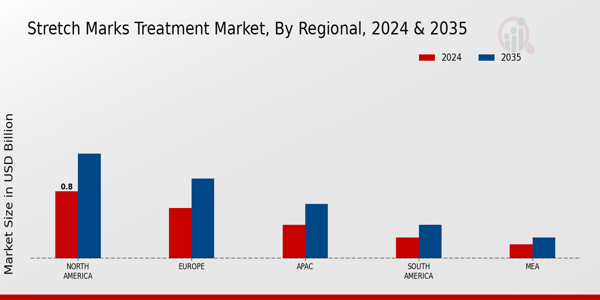Increase in Obesity Rates
The rising global obesity rates are contributing to the prevalence of stretch marks, thereby impacting the Global Stretch Marks Treatment Market Industry. As individuals experience rapid weight gain or loss, the skin undergoes significant stretching, leading to the formation of stretch marks. This trend is particularly concerning in regions where obesity rates are climbing, prompting a greater need for effective treatment solutions. Health organizations continue to report alarming statistics regarding obesity, which in turn drives consumer demand for stretch mark treatments. The market is expected to respond to this growing need, further solidifying its position in the health and wellness sector.
Market Growth Projections
The Global Stretch Marks Treatment Market Industry is poised for substantial growth, with projections indicating a market value of 2.22 USD Billion in 2024 and an anticipated increase to 3.5 USD Billion by 2035. This growth trajectory suggests a compound annual growth rate of 4.23% from 2025 to 2035. Such figures reflect the increasing consumer focus on skin care and the demand for effective stretch mark treatments. The market's expansion is likely to be driven by various factors, including technological advancements, rising awareness, and changing demographics. These projections underscore the potential for investment and innovation within the industry.
Rising Awareness of Skin Health
The Global Stretch Marks Treatment Market Industry is experiencing a notable increase in consumer awareness regarding skin health and aesthetics. This heightened consciousness is driven by social media and the proliferation of beauty influencers who emphasize the importance of skin care. As individuals become more informed about the options available for treating stretch marks, the demand for effective treatments is likely to rise. This trend is particularly evident among younger demographics, who are increasingly seeking preventive measures. Consequently, the market is projected to reach 2.22 USD Billion in 2024, reflecting a growing inclination towards maintaining skin appearance.
Expansion of E-commerce Platforms
The Global Stretch Marks Treatment Market Industry is witnessing a transformation due to the expansion of e-commerce platforms. Online retailing provides consumers with convenient access to a wide range of stretch mark treatment products, from topical creams to advanced therapies. This shift towards digital shopping is particularly appealing to younger consumers who prefer the convenience of online purchases. E-commerce platforms also facilitate the dissemination of information regarding product efficacy and user reviews, which can influence purchasing decisions. As online sales channels continue to grow, they are likely to play a pivotal role in the market's expansion, making treatments more accessible to a broader audience.
Growing Demand from Pregnant Women
Pregnancy is a primary factor contributing to the prevalence of stretch marks, thus driving demand within the Global Stretch Marks Treatment Market Industry. As more women seek effective solutions to manage and prevent stretch marks during and after pregnancy, the market is likely to expand. Products specifically formulated for pregnant women, such as creams and oils, are gaining popularity. This demographic shift is indicative of a broader trend towards maternal health and wellness. The market's growth trajectory is further supported by a projected compound annual growth rate of 4.23% from 2025 to 2035, highlighting the increasing focus on post-pregnancy skin care.
Technological Advancements in Treatment Options
Innovations in dermatological technology are significantly influencing the Global Stretch Marks Treatment Market Industry. New treatment modalities, such as laser therapy and microdermabrasion, are being developed, offering enhanced efficacy and reduced recovery times. These advancements not only improve treatment outcomes but also expand the range of options available to consumers. For instance, fractional laser treatments have shown promising results in clinical studies, leading to increased patient satisfaction. As these technologies become more accessible, they are expected to drive market growth, contributing to a projected market value of 3.5 USD Billion by 2035.















